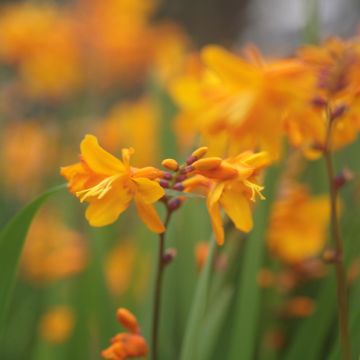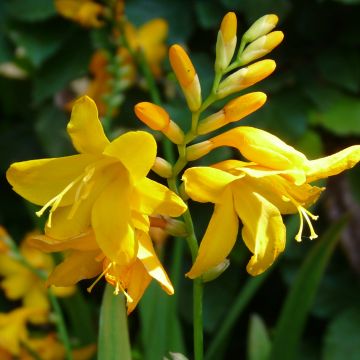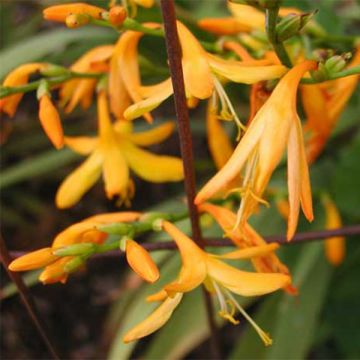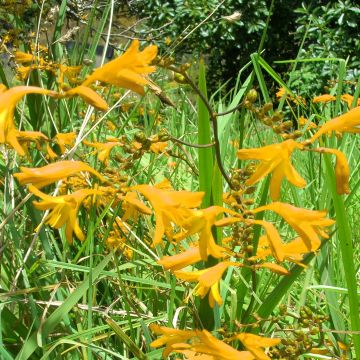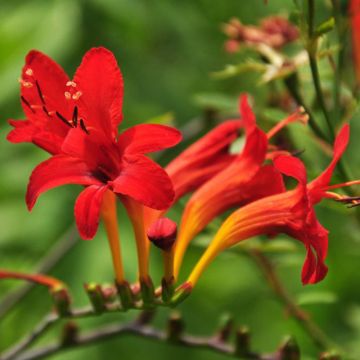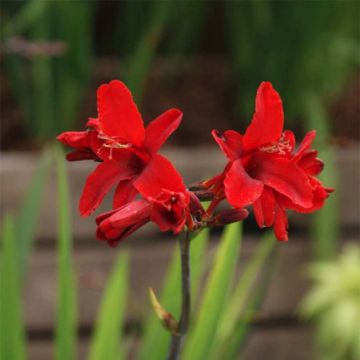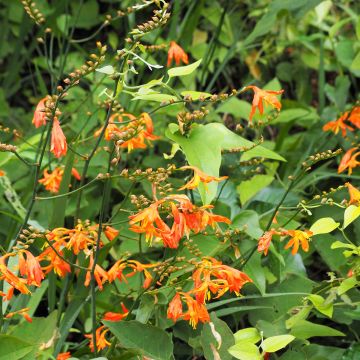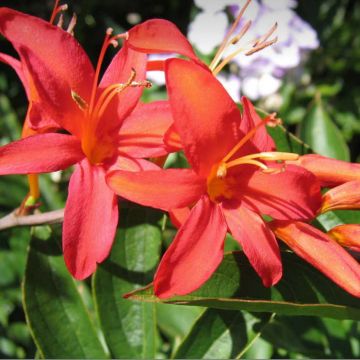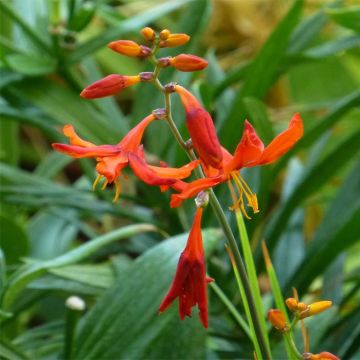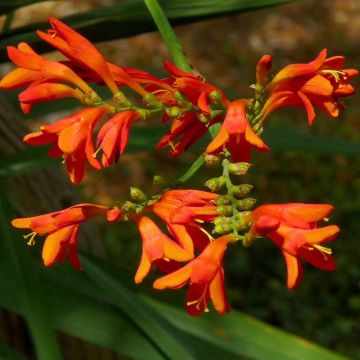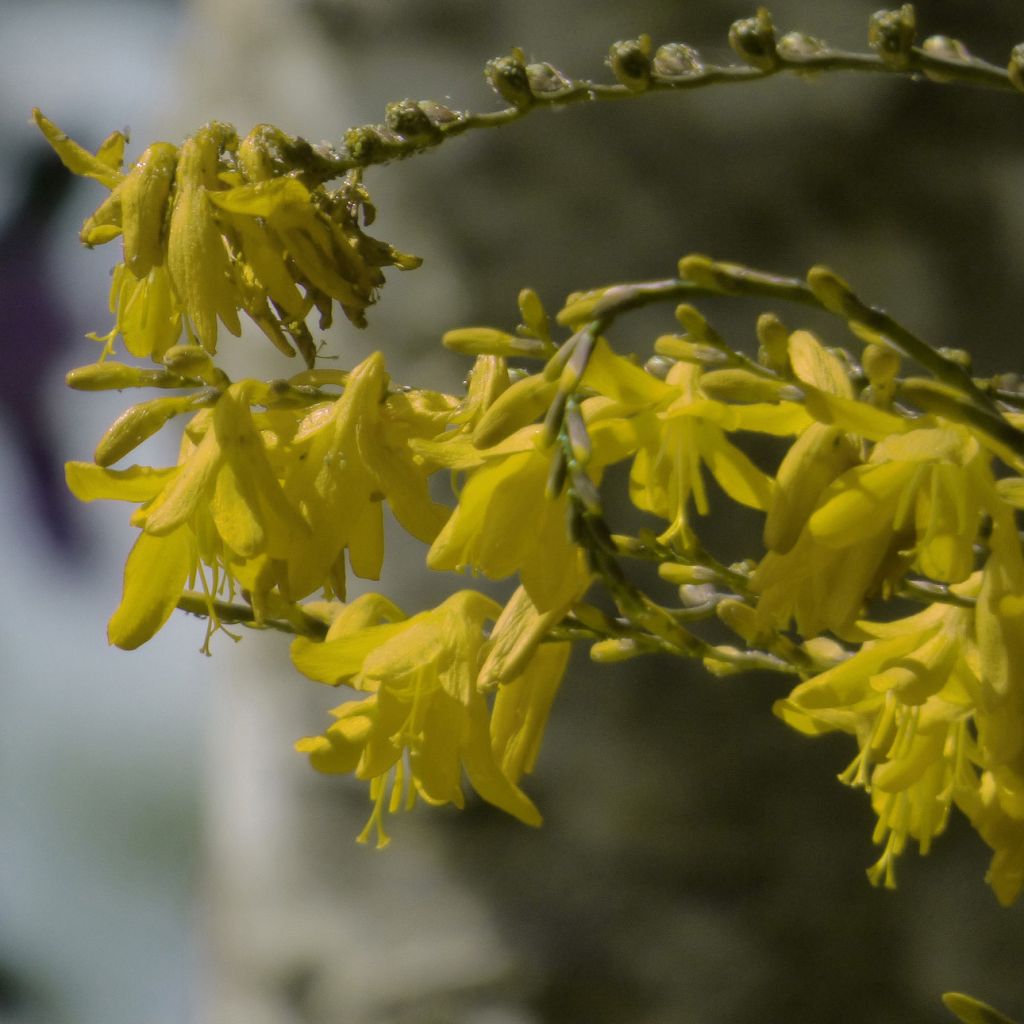

Crocosmia crocosmiiflora Solfatare, Montbretia
Crocosmia Solfatare - Montbretia
Crocosmia crocosmiiflora Solfatare
Montbretia
I didn't have the number of bulbs ordered (one less), but they looked very good. They grew, but I don't know why they didn't flower this summer. Poor exposure??
Chantal O., 18/11/2018
Why not try an alternative variety in stock?
View all →This plant carries a 6 months recovery warranty
More information
We guarantee the quality of our plants for a full growing cycle, and will replace at our expense any plant that fails to recover under normal climatic and planting conditions.
From €5.90 for pickup delivery and €6.90 for home delivery
Express home delivery from €8.90.


Does this plant fit my garden?
Set up your Plantfit profile →
Description
Crocosmia x crocosmiiflora 'Solfatare' is a variety of Montbretia that has been captivating gardeners for over 100 years with its hardiness and unique charm. This plant has beautiful iris-like foliage tinged with bronze or even caramel and produces graceful arching stems adorned with small, delicate flowers that start a lovely apricot yellow and lighten with time, an easy colour to accommodate in the garden. This perennial is stunning in borders or even near water features and provides beautiful cut flowers.
Crocosmia is a herbaceous perennial plant native to South Africa, belonging to the family Iridaceae. It shares many similarities with gladiolus and is often cultivated in a similar way, except in colder regions. In the wild, Crocosmia thrives in sunny locations with fertile, moist soil in summer and drier conditions in winter. In the garden, they will tolerate cold and damp winters to varying degrees, depending on the species and varieties. 'Solfatare' performs well in most regions, planted in well-draining soil and protected by a thick layer of mulch.
The 'Solfatare' variety was selected in France in 1887. In spring, this Montbretia forms a clump of flexible basal leaves, reaching a height of 50 cm (20in), which quickly spreads. After 3 to 4 years of cultivation under good conditions, this clump of leaves can cover almost 50 cm (20in) of ground. Flowering takes place in July and August, with slightly arching stems that can reach a height of 60 cm (24in). They bear a nearly horizontal branched spike of numerous apricot yellow buds that open into slightly star-shaped flowers, directed horizontally or upwards, resembling small yellow-orange daylilies with a diameter of about 4 cm (2in). The sword-shaped leaves are strongly tinged with bronze caramel, especially at the base. Their surface is pleated and strongly veined, and they spread out in a dense fan or cluster from the base of the plant. The storage organ is a corm, which is a swollen stem surrounded by scales.
Montbretias symbolise summer and bring all the exoticism of their origins to our gardens. They are easy to grow, vigorous, and undemanding planted in sunny locations in groups of 10 corms, in fertile and moist soil in summer. Their vibrant colours, yellow, orange, or red, create cheerful spots of colour in gardens. 'Solfatare' forms a beautiful combination with purple or blue asters. It also pairs well with catmints and sneezeweeds, in front of screens of golden or very dark foliage provided by Physocarpus or Cotinus. In a more contemporary or naturalistic style, Crocosmias mingle with grasses and Phormiums. When they thrive in the ground in sunny exposure and rich, well-drained soil, they multiply and become more beautiful each year. They are also excellent flowers for cutting.
Report an error about the product description
Crocosmia Solfatare - Montbretia in pictures
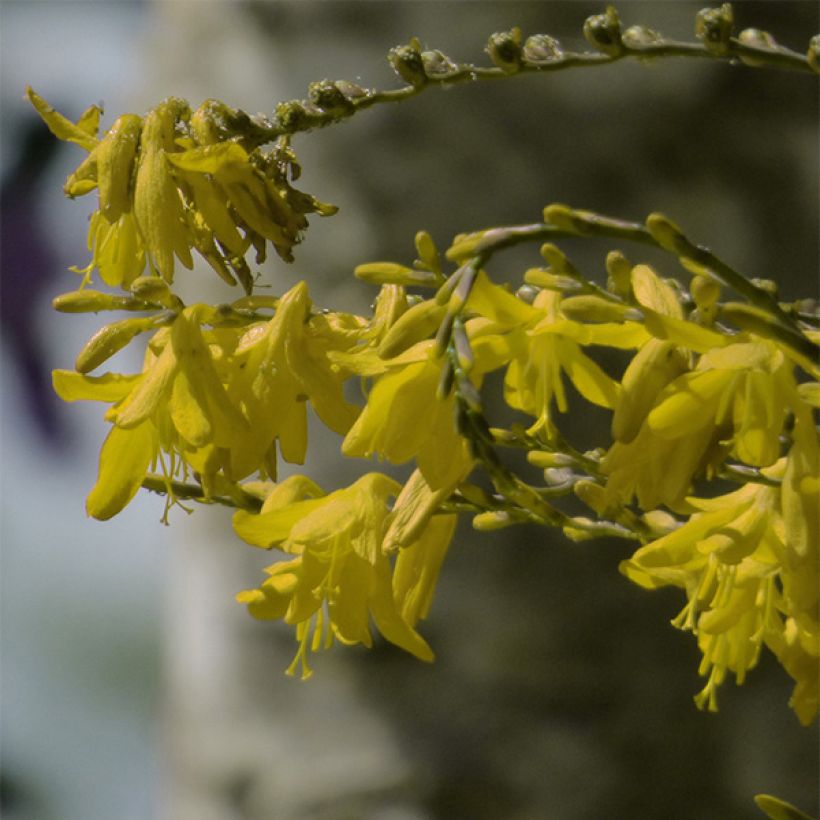

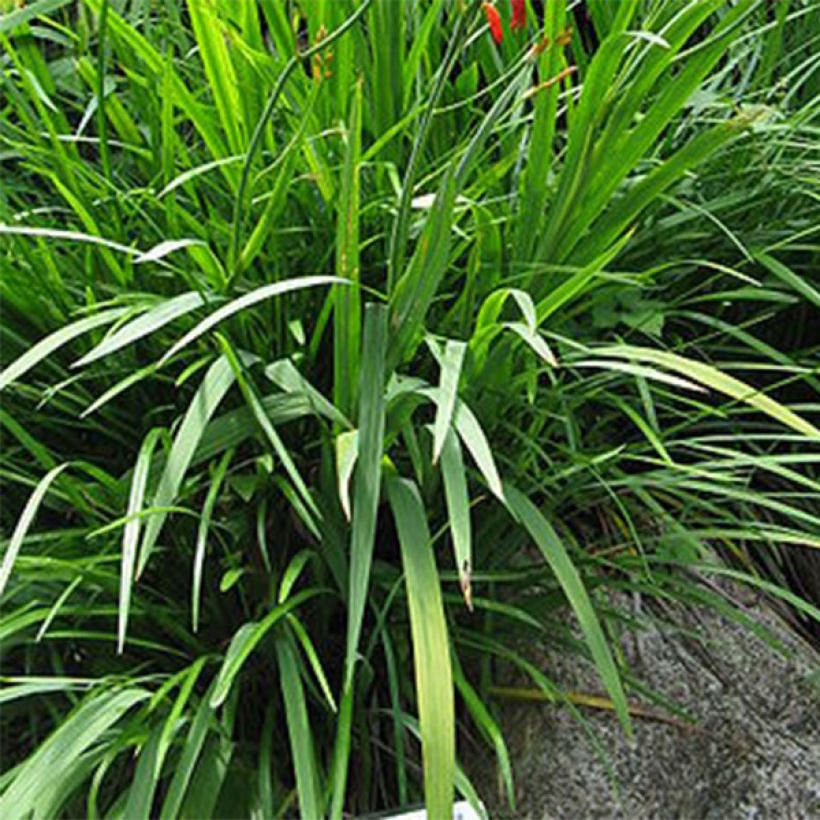

Plant habit
Flowering
Foliage
Botanical data
Crocosmia
crocosmiiflora
Solfatare
Iridaceae
Montbretia
Cultivar or hybrid
Other Crocosmia
Planting and care
Plant crocosmias in full sun, preferably in spring. They need well-drained and loose soil that does not retain too much water in winter if they are to remain in the ground. On the other hand, they require moist soil in summer. Work the soil well at the time of planting and if necessary incorporate some sand. They should be covered with at least 5 to 8 cm (2 to 3in) of soil (the more they are buried, the better they resist frost) and spaced about fifteen cm apart. They like rich soils. Apply fertiliser at the time of planting and every spring. While they prefer well-drained soil in winter, crocosmias need plenty of water during their growing season and cannot tolerate any drought in summer. In regions with harsh winters, it is a good idea to dig up the corms once the foliage has dried out and store them in a frost-free location. An alternative is to cover the bed with a thick insulating mulch at the onset of winter and remove it in March.
The 'Solfatare' Crocosmia is capable of withstanding short frosts of around -15°C (5°F), provided the soil is well drained: plant it on a raised bed where water will not stagnate. Protect the crown with a thick mulch that will insulate it from cold and excessive moisture.
Crocosmias thrive in oceanic climate regions. Contrary to what is sometimes read, they are not adapted to the Mediterranean climate, which is much too dry in summer in a garden without regular irrigation.
Planting period
Intended location
Care
-
, onOrder confirmed
Reply from on Promesse de fleurs
Haven't found what you were looking for?
Hardiness is the lowest winter temperature a plant can endure without suffering serious damage or even dying. However, hardiness is affected by location (a sheltered area, such as a patio), protection (winter cover) and soil type (hardiness is improved by well-drained soil).

Photo Sharing Terms & Conditions
In order to encourage gardeners to interact and share their experiences, Promesse de fleurs offers various media enabling content to be uploaded onto its Site - in particular via the ‘Photo sharing’ module.
The User agrees to refrain from:
- Posting any content that is illegal, prejudicial, insulting, racist, inciteful to hatred, revisionist, contrary to public decency, that infringes on privacy or on the privacy rights of third parties, in particular the publicity rights of persons and goods, intellectual property rights, or the right to privacy.
- Submitting content on behalf of a third party;
- Impersonate the identity of a third party and/or publish any personal information about a third party;
In general, the User undertakes to refrain from any unethical behaviour.
All Content (in particular text, comments, files, images, photos, videos, creative works, etc.), which may be subject to property or intellectual property rights, image or other private rights, shall remain the property of the User, subject to the limited rights granted by the terms of the licence granted by Promesse de fleurs as stated below. Users are at liberty to publish or not to publish such Content on the Site, notably via the ‘Photo Sharing’ facility, and accept that this Content shall be made public and freely accessible, notably on the Internet.
Users further acknowledge, undertake to have ,and guarantee that they hold all necessary rights and permissions to publish such material on the Site, in particular with regard to the legislation in force pertaining to any privacy, property, intellectual property, image, or contractual rights, or rights of any other nature. By publishing such Content on the Site, Users acknowledge accepting full liability as publishers of the Content within the meaning of the law, and grant Promesse de fleurs, free of charge, an inclusive, worldwide licence for the said Content for the entire duration of its publication, including all reproduction, representation, up/downloading, displaying, performing, transmission, and storage rights.
Users also grant permission for their name to be linked to the Content and accept that this link may not always be made available.
By engaging in posting material, Users consent to their Content becoming automatically accessible on the Internet, in particular on other sites and/or blogs and/or web pages of the Promesse de fleurs site, including in particular social pages and the Promesse de fleurs catalogue.
Users may secure the removal of entrusted content free of charge by issuing a simple request via our contact form.
The flowering period indicated on our website applies to countries and regions located in USDA zone 8 (France, the United Kingdom, Ireland, the Netherlands, etc.)
It will vary according to where you live:
- In zones 9 to 10 (Italy, Spain, Greece, etc.), flowering will occur about 2 to 4 weeks earlier.
- In zones 6 to 7 (Germany, Poland, Slovenia, and lower mountainous regions), flowering will be delayed by 2 to 3 weeks.
- In zone 5 (Central Europe, Scandinavia), blooming will be delayed by 3 to 5 weeks.
In temperate climates, pruning of spring-flowering shrubs (forsythia, spireas, etc.) should be done just after flowering.
Pruning of summer-flowering shrubs (Indian Lilac, Perovskia, etc.) can be done in winter or spring.
In cold regions as well as with frost-sensitive plants, avoid pruning too early when severe frosts may still occur.
The planting period indicated on our website applies to countries and regions located in USDA zone 8 (France, United Kingdom, Ireland, Netherlands).
It will vary according to where you live:
- In Mediterranean zones (Marseille, Madrid, Milan, etc.), autumn and winter are the best planting periods.
- In continental zones (Strasbourg, Munich, Vienna, etc.), delay planting by 2 to 3 weeks in spring and bring it forward by 2 to 4 weeks in autumn.
- In mountainous regions (the Alps, Pyrenees, Carpathians, etc.), it is best to plant in late spring (May-June) or late summer (August-September).
The harvesting period indicated on our website applies to countries and regions in USDA zone 8 (France, England, Ireland, the Netherlands).
In colder areas (Scandinavia, Poland, Austria...) fruit and vegetable harvests are likely to be delayed by 3-4 weeks.
In warmer areas (Italy, Spain, Greece, etc.), harvesting will probably take place earlier, depending on weather conditions.
The sowing periods indicated on our website apply to countries and regions within USDA Zone 8 (France, UK, Ireland, Netherlands).
In colder areas (Scandinavia, Poland, Austria...), delay any outdoor sowing by 3-4 weeks, or sow under glass.
In warmer climes (Italy, Spain, Greece, etc.), bring outdoor sowing forward by a few weeks.

































